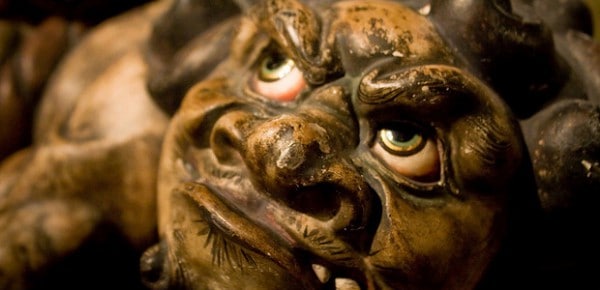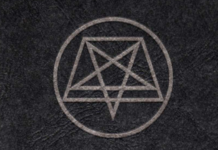Let’s get something straight. Thelema is most certainly satanic, but it is not in any way, whatsoever, Satanism. Now, I am sure many reading this statement will ask, what’s the difference? The answer lies in the role Satan plays.
With my Hawk’s head I peck at the eyes of Jesus as he hangs upon the cross.
Aleister Crowley, Liber AL vel Legis, III:51
Satanism, as represented by Christianity and by self-proclaimed Satanists, revolves around the figure of Satan, regardless of whether Satan is considered objectively real or solely mythological. Satan is real and the focus of worship, according to the Christians, and in institutional Satanism, Satan is either a central model, but is unreal, such as in the Church of Satan; or is real and has an active role in the initiation of the individual as in the Temple of Set. Then there are the many, many other Satan-focused groups where Satan plays an important role in some fashion. All these forms of Satanism are satanic. They reject, or even oppose the doctrine and practices of Christianity and are associated with Satan in some form. But not all religions or groups that are satanic are forms of Satanism.
Our religion therefore, for the People, is the Cult of the Sun, who is our particular star of the Body of Nuit, from whom, in the strictest scientific sense, come this earth, a chilled spark of Him, and all our Light and Life. His vice-regent and representative in the animal kingdom is His cognate symbol the Phallus, representing Love and Liberty. Ra-Hoor-Khuit, like all true Gods, is therefore a Solar-Phallic deity.
Aleister Crowley, New Comment to Liber AL, verse III:22
Thelema is a solar-phallic gnostic religio-philosophy, or religion as some prefer to call it. It opposes the beliefs and practices of Christianity — among other religions — and offers in its place the central role of the individual and the procreative aspects of life, symbolized by both the sun and the phallus. It is satanic because it opposes the assertions of Judaism and Christianity regarding the role God, Jesus, original sin, and so forth, and values the myth of Satan as one who rebelled again Jehovah. Thelema rejects all these notions that enslave humanity to a deity that would demand certain beliefs and actions and punish those who disobey. Satan represents the rejection of this belief system and the exultation of the individual. Is Satan central to Thelema? No. Is Satan mentioned in Thelema? Yes, frequently.
It is also to be considered that Nu is connected with North, while Had is Sad, Set, Satan, Sat (equals “Being” in Sanskrit), South. He is then the Sun, one point concentring Space, as also is any other star. The word ABRAHADABRA is from Abrasax, Father Sun, which adds to 365.
ibid., verse I:1
Satan, as illustrated above, is often lumped together with other deities from various mythologies (including Christianity) and is organized according to classical characteristics. Satan is associated with the south, with the element fire or air.1 These are also the elements associated with the Egyptian god, Ra, the sun. So is Satan important in the Thelemic system? Yes. Is he the central figure or model worshipped? No. Satan is just one deity of many associated with some aspect of the solar-phallus which is the central idea or thing worshipped in Thelema. This becomes even more apparent when one examines the suggested rituals of Thelema devised by Aleister Crowley. They mention numerous deities and names of God, but rarely does Satan comes up, and usually only in commentaries.2 So why does Satan come up in the first place? Thelema uses the divine names, images, stories and characteristics of a variety of religions and mythologies in its literature and practice. The central deities in Liber AL, are represented as Egyptian. Crowley frequently makes reference to classical mythologies of the Greeks and Romans—such as in his Hymn to Pan, or his use of the Greek name, To Mega Therion. But probably the most influential mythology informing and underlying Thelema is that of the Abrahamic myths, Judaism, Christianity and Islam. This is apparent in a variety of places including Crowley’s moniker, The Great Beast, a reference to the Book of Revelation. Other influences on Thelema directly related to Christianity are its millennialism, its emphasis on texts, and the use of certain names and actions in ritual, including the Gnostic Mass, which was modelled on a Christian Eucharistic ceremony. Crowley’s own background and the immersion in fundamentalist Protestantism resulted in a significant Christian influence on Thelema. Sometimes this manifested in symbolism, action, or belief. Other times it emerged as a distinct anti-Christian rhetoric, action, or belief. This is why the symbol of Satan, as the adversary or rebel to the Christian god, was a frequent theme in Crowley’s work. Those who try to downplay Satan’s presence in Thelemic material are trying to white wash Thelema’s distinct anti-Christian nature and the valuing of the myth of Satan. But being anti-Christian, however, does not mean Thelema is a form of Satanism. It does, however, mean that Thelema is certainly satanic. Ultimately the difference comes down to semantics. Do Thelemites worship Satan — as deity or otherwise? No. Is Satan a common and potent symbol in Thelemic literature? Yes. For some, the simple mention of Satan in a positive light is enough to claim Thelema is a form of Satanism. This type of thinking, however, would also mean that Thelema is an Egyptian religion, as it frequently mentions Egyptian deities; is a Hellenistic religion, as it frequently references classical Greek deities; as well as a Roman religion and a form of Islam, because all these mythologies are referenced positively in Thelemic literature. Thelemic literature values the myth of Satan, its symbolism and narrative without immediately jumping to the worship of Satan. Thus, Thelema is satanic but is not a form of Satanism. Image credit: Orin Zebest
- In a footnote in 777, Aleister Crowley writes, “In The Book of the Sacred Magic of Abramelin the Mage (tom. II cap. XIX) are tabulated the names of various Evil Spirits: chief among these are the “Four Princes and Superior Spirits”, to wit Lucifer, Leviathan, Satan and Belial who may perhaps be referred to the Elements (I would suggest fire, water, air, earth respectively).” [↩]
- One example is the following footnote in Liber V vel Reguli, “In LA note that Saturn or Satan is exalted in the House of Venus or Astarté and it is an airy sign. Thus L is Father-Mother, Two and Naught, and the Spirit (Holy Ghost) of their Love is also Naught.” Notice how Satan is just one deity of many mentioned in this one sentence. To Mega Therion is Greek for “The Great Beast.” [↩]









